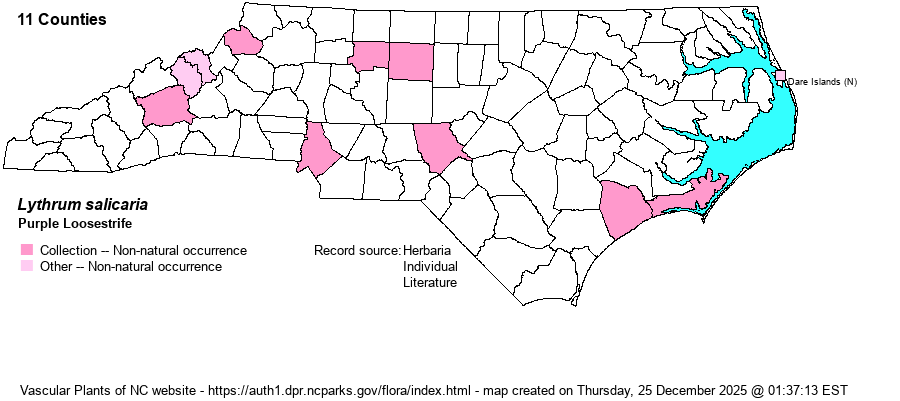| Author | L. | |
| Distribution | Scattered locations across the state. No doubt more populations will be found. First collected in NC as a cultivated ornamental in a garden in Forsyth County in 1935. First found outside of cultivation in 1956 and 1961 at Bass Lake in Watauga County; next in 1977 and 1986 at the outlet of Beaverdam Lake in Buncombe County. The rest of our records are from 1992-2009. Stalter and Lamont (1997) reported it from Duck on the Outer Banks.
Native of Eurasia; in N.A. in every southern Canadian province and US state except FL, LA, and SC. This is one of the most problematic and aggressive alien weeds in North America, replacing native vegetation from whole marshes or sections of marshes. For now, most of this damage has occurred in states well to the north of NC. | |
| Abundance | Rare on the landscape in NC, as far as we know. Populations have varied (where information is provided) from a single clump to 2 plants, to "large colony" beside I-40 near Winston-Salem in Forsyth County in 1992, and "abundant around dam runoff pond" in Mecklenburg County in 1993. Only 2 labels mention eradicating the plants. | |
| Habitat | Wet soil of impoundment margins, artificial lakes, marshes, roadside ditches, creek margins. |
| Phenology | Flowering and fruiting June-September. | |
| Identification | Purple Loosestrife is a tall and rank herb that usually grows about 3 feet tall, but may reach much higher. Leaves are opposite and narrow. Flowers are produced in a terminal spike-like inflorescence that may remain straight or arch over a bit. Flowers are handsome, dark pink or rosy, petals 6. You do not want to see a marsh or bog full of deep rose-colored spires of flowers in NC! | |
| Taxonomic Comments | | |
| Other Common Name(s) | | |
| State Rank | SE | |
| Global Rank | G5 | |
| State Status | | |
| US Status | | |
| USACE-agcp | OBL link |
| USACE-emp | FACW link |

